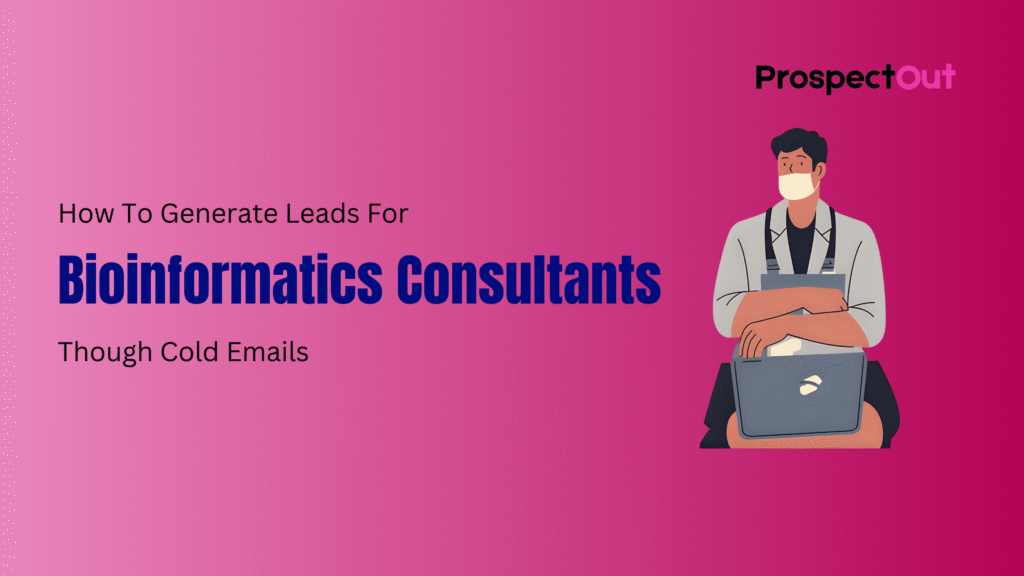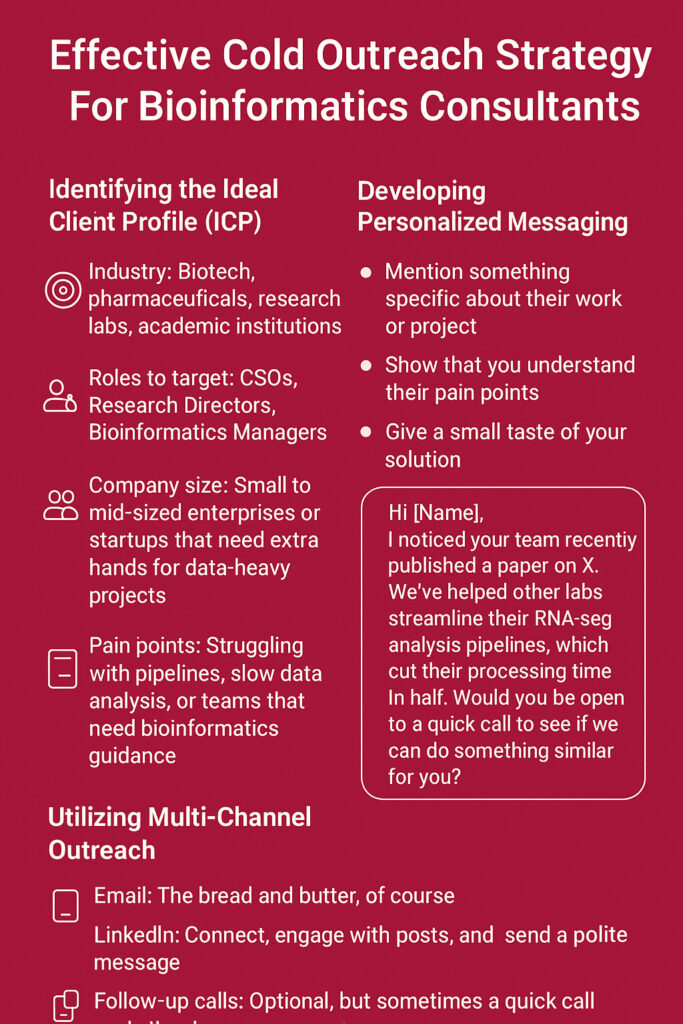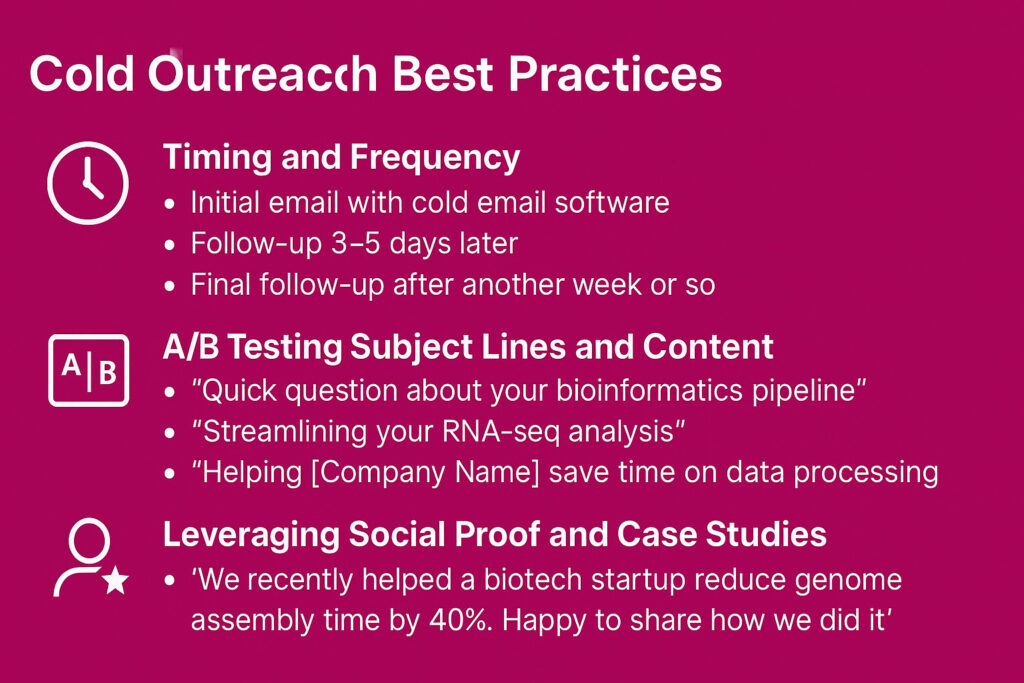
Hey, so let’s talk about something that’s both exciting and a little nerve-wracking: getting leads as a bioinformatics consultant. I know, it sounds super technical and maybe even intimidating.
But trust me, generating leads doesn’t have to be complicated.
If you’re offering services like genomic analysis, pipeline development, or bioinformatics training, the real challenge isn’t just doing great work.
It’s finding the right clients who actually need your expertise. That’s where cold outreach comes in. And no, I’m not talking about spammy emails that get ignored. You’ll learn how to do it smartly, personally, and effectively.
By the end of this, you’ll have a clear game plan for finding leads, reaching out to them, and converting those cold connections into actual clients.
Understanding the Bioinformatics Consulting Landscape
Key Services Offered by Bioinformatics Consultants
Before we dive into outreach, let’s briefly review what bioinformatics consultants do. You might be:
- Helping biotech companies make sense of large datasets.
- Designing or optimizing bioinformatics pipelines.
- Providing statistical analysis for genomic or proteomic studies.
- Offering training sessions or workshops to help teams work more efficiently with computational tools.
Knowing this helps you target the right people. Because a pharma startup might need pipeline development, while a research institute might just need a few workshops.
Challenges Faced in Lead Generation
Honestly, a lot of consultants struggle with lead generation. Why?
- Many researchers and executives are extremely busy and receive numerous outreach requests.
- Your niche is technical, so it’s harder to explain your value in just a couple of sentences.
- It’s easy to feel like you’re “selling out” by reaching out. But done right, it’s really just helping someone solve a problem.
Effective Cold Outreach Strategy For Bioinformatics Consultants
Alright, this is where it gets fun. Cold outreach doesn’t have to feel cold at all. It’s all about being thoughtful, personal, and helpful.

Identifying the Ideal Client Profile (ICP)
Think of it like this: you don’t want to pitch a genomic analysis service to a company that only deals with environmental data. So, here’s your sweet spot:
- Industry: Biotech, pharmaceuticals, research labs, academic institutions.
- Roles to target: CSOs, Research Directors, Bioinformatics Managers.
- Company size: Small to mid-sized enterprises or startups that need extra hands for data-heavy projects.
- Pain points: Struggling with pipelines, slow data analysis, or teams that need bioinformatics guidance.
Knowing this keeps your outreach focused and saves a lot of wasted time.
Developing Personalized Messaging
This is the part where many people trip up. Don’t send a generic email like everyone else. Instead:
- Mention something specific about their work or project.
- Show that you understand their pain points.
- Give a small taste of your solution. Something actionable or helpful.
Example:
“Hi [Name], I noticed your team recently published a paper on X. We’ve helped other labs streamline their RNA-seq analysis pipelines, which cut their processing time in half. Would you be open to a quick call to see if we can do something similar for you?”
See? Short, personal, and clearly valuable.
Utilizing Multi-Channel Outreach
Don’t rely on just email. A smart cold outreach strategy uses:
- Email: The bread and butter, of course.
- LinkedIn: Connect, engage with posts, and send a polite message.
- Follow-up calls: Optional, but sometimes a quick call seals the deal.
The key is consistency and personalization across channels, not spamming.
Cold Outreach Best Practices For Bioinformatics Consultants
Now, let’s ensure your outreach is actually effective.

Timing and Frequency
You don’t want to send five emails in one day. A good rule:
- Initial email with cold email software
- Follow-up 3–5 days later
- Final follow-up after another week or so
Keep it respectful but persistent.
A/B Testing Subject Lines and Content
Try different subject lines to see what grabs attention. Short, personal, and curiosity-driven often works best. Examples:
- “Quick question about your bioinformatics pipeline”
- “Streamlining your RNA-seq analysis”
- “Helping [Company Name] save time on data processing”
Then test email bodies too. Track open rates, click rates, and replies.
Leveraging Social Proof and Case Studies
If you’ve worked with a reputable lab or company, mention it. People trust results and examples:
“We recently helped a biotech startup reduce genome assembly time by 40%. Happy to share how we did it.”
It’s simple, but powerful.
Tools and Resources for Cold Outreach Campaigns
Here’s where tech can save your sanity.
Email Automation Platforms
Tools like SalesHandy, Yesware, or Lemlist let you automate emails without feeling robotic. Personalization tokens, scheduling, and tracking are lifesavers.
Lead Databases
For bioinformatics, establishing the right contacts can be challenging. BioScoutr or LinkedIn Sales Navigator can help you find decision-makers at the exact companies you want to target.
CRM Systems
Once you have leads, you need to track them. CRMs like HubSpot or Pipedrive let you see which leads replied, who needs follow-ups, and what’s working best.
Measuring and Optimizing Outreach Efforts
You can’t improve what you don’t measure. Track these key metrics:
- Open rate – Are people actually seeing your emails?
- Reply rate – Are they interested enough to respond?
- Conversion rate – How many leads actually become clients?
Based on these metrics, tweak subject lines, message content, and timing. Always be testing, always be improving.
Conclusion
So, that’s the gist of it. Cold outreach for bioinformatics consulting doesn’t have to be scary or impersonal. It’s about knowing your ideal client, crafting personalized, helpful messages, using the right tools, and being consistent.
If you follow these steps, you’re not just sending emails. You’re opening doors to collaborations, helping teams solve real problems, and growing your consulting business in a smart, strategic way.


